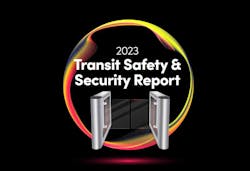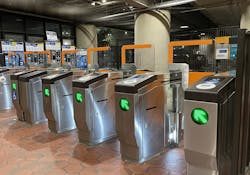Customers continue their steady return to transit systems throughout North America and as ridership numbers increase, the spotlight has grown brighter on how systems can be made safer for riders and employees. Partnerships with local entities, including law enforcement and community groups, advanced technology and new policies at the state and federal levels all support the work individual agencies are doing to ensure their systems remain a safe environment for all.
In California, a new state law will require the top 10 transit operators to collect and publish data on street harassment incidents to inform their individual agency responses to rider safety concerns. The bill, SB 434, will task Mineta Transportation Institute at San Jose State University with developing a survey the agencies can use to collect uniform data. The survey is required to be ready by Dec. 31, 2023, and the top 10 agencies in the state have until Dec. 31, 2024, to collect the data and publish it.
According to the bill’s lead author, State Sen. Dave Min (D-37), the law emphasizes outreach initiatives, targeting specific groups such as women, non-English speakers, members of the LGBTQ+ community and riders with disabilities. Multiple studies cited in the law have determined these groups face a higher risk of street harassment.
“The research is clear: Women, people of color and individuals from LGBTQIA+ community experience disproportionate levels of verbal and physical harassment while riding public transit,” noted Michael Pimentel, executive director of the California Transit Association. “California’s transit agencies are committed to addressing this unfortunate truth through enhanced engagement with their riders and through the advancement of new evidence-based solutions. We see SB 434 as a central strategy in this work and as a critical step to ensuring the safety of all riders and welcoming our communities back to our systems.”
Moving to a more local level, boards of directors, including those at New Jersey Transit (NJ Transit) and TriMet, have taken steps in the past year to empower their agencies to suspend or ban offenders from using transit in their jurisdictions under certain circumstances, such as assaults on operators or passengers, while also preserving avenues to appeal these potential suspensions or bans.
TriMet’s amended code expands the types of offenses that can result in long-term exclusions, including those that stretch from six months to a lifetime ban. Felonies were included under the scope of the previous long-term exclusion policy, but attempted felonies and Class A misdemeanors—the most serious category, which includes fourth-degree assault and some bias crimes—were not. These types of crimes are now eligible for longer exclusions under the amended code.
NJ Transit adopted regulations in July 2023 that established a procedure by which the agency is able to administratively suspend ridership privileges for individuals who assault transit employees while also creating due process for offenders to appeal proposed suspensions.
The regulations create progressive sanctions, with the length of the suspension increasing with each ensuing offense and provide due process to individuals facing a suspension. The rules also set procedures for the creation of a Ridership Appeal Board, when necessary, to review initial determinations made by NJ Transit. The regulations are supported by legislation signed into law in January 2022 that enables NJ Transit and other carriers to suspend or prohibit individuals who commit assaults against employees. The law also ensures the state’s mobility providers equip buses and trains with communications systems to quickly contact law enforcement in an emergency.
Moving to the federal level, the Federal Transit Administration (FTA) recently issued two Notices of Proposed Rulemaking (NPRM) pertaining to transit safety. In a proposal issued at the end of October, FTA proposes an update to the Public Transportation Safety Certification Training Program regulation that would build upon existing training requirements for safety professionals in rail transit agencies and ensures the training curriculum is more responsive to evolving industry needs. According to FTA, the proposed changes in the NPRM would expand refresher training requirements for mandatory participants and allow for greater flexibility in the curriculum to address changing industry training needs. The NPRM would also streamline administrative requirements to help ensure individuals who serve in designated roles are enrolled in the program and complete training requirements on time.
A second NPRM issued in mid-November would give State Safety Oversight Agencies (SSOAs) the right to inspect rail transit agencies without warning, require agencies to collect metrics and data that better explain rail transit safety and require SSOAs to create an inspection program to decrease risk.
Following issuance of the SSOA proposal, FTA Administrator Nuria Fernandez said, "We intend to make transit one of the safest forms of surface transportation, even safer.”
Beyond proposed rules changes, FTA is looking to research efforts to bolster transit safety initiatives throughout the U.S. In late August, FTA awarded a $500,000 research grant to the University of South Florida to identify safety risks for transit workers and riders and determine the most effective strategies to minimize them. The grant award is the first phase of FTA's Transit Worker and Rider Safety Best Practices initiative. After identifying best practices, a second phase of research will provide technical and financial support to the transit industry and supportive organizations to pursue innovative approaches to reduce safety hazards affecting workers, riders and transit systems.
Technology boosting security
On the security side of the equation, transit systems have taken steps to improve lighting at stations, equip employees and security personnel with additional communication tools and piloted components, including operator barrier doors and new fare gates to bolster security of systems.
In March 2023, the Washington Metropolitan Area Transit Authority (WMATA) Metro Transit Police Department (MTPD) launched its Body-Worn Camera Program, which will rollout body-worn cameras in stages to MTPD officers, sergeants and lieutenants who are trained in the equipment. The body-worn cameras will supplement the more than 20,000 cameras WMATA has throughout the rail, bus and paratransit system to further strengthen public safety and security efforts.
A new MTPD policy was established to ensure recordings, investigations and retention of records are conducted in accordance with best practices. The MTPD’s Community Services Bureau also began working to ensure customers are educated and informed about the deployment, protocols and use of body-worn cameras.
Another new technology WMATA has deployed that has had a measurable impact on the system is new faregates. In August, the authority reported the higher, stronger fare gates, which feature an L-shaped door panel, had reduced fare evasion by 70 percent at the stations where the gates were installed.
In Missouri, Bi-State Development Agency began its Secure Platform Plan for St. Louis Metro’s MetroLink stations. The plan is described as a multi-tiered strategy to grow ridership and deliver a stronger transit experience by creating centralized, highly secure customer entrances at all 38 MetroLink stations. The planned upgrades at the stations include welded-wire fencing, roto-gates and swing gates and closed-circuit cameras, among other technology deployed to promote a more secure system.
Additionally, St. Louis Metro began a pilot program in May where metal detectors started being rotated at MetroLink stations in St. Louis, Mo., St. Louis County, Mo., and St. Clair County, Ill. Riders who wish to enter a station where a metal detector is installed will need to walk through them to gain access to the station. The pilot program will be in partnership with St. Louis Metro Transit’s three law enforcement partners – the St. Louis County Police Department, St. Louis Metropolitan Police Department and the St. Clair County Police Department. Police officers will assist in staffing the metal detector checkpoints.
Partnerships and outreach efforts
The responsibility of improving safety on transit systems is an easier lift with community partners who can bring fresh perspectives and needed expertise to a challenge that will benefit transit systems and the communities in which they operate.
Several transit agencies have worked to increase the number of transit police employed on their systems or partnered with local law enforcement entities to increase uniformed personnel presence. On systems operating in Atlanta, Chicago and San Francisco, this increased presence has been credited with a reduction in transit crime statistics.
In Vancouver, British Columbia, the Metro Vancouver Transit Police launched its Community Safety Officer (CSO) program in 2023. The program introduced a new category of frontline transit police employees who will supplement patrol police officers. CSOs assist with tasks, including community engagement, transit safety education, collection of evidence, perimeter security at police incidents, crowd control, fare enforcement and support at major events and emergencies, along with other responsibilities. In November 2023, the first 10 CSOs completed their 17-week training and began patrolling the transit system followed shortly after by the second class of CSOs who began their training.
“It’s exciting to see the Community Safety Officers program come to fruition. Their status as peace officers will empower CSOs to enforce transit bylaws and the transit conduct and safety regulations, bringing a new level of safety to the transit system,” said Metro Vancouver Transit Police Constable Amanda Steed.
In addition to law enforcement partners, transit agencies have started ambassador programs in increasing numbers, with successful programs being launched in Seattle, San Francisco, Philadelphia, Indianapolis, Cleveland, Calgary, Alberta and the Toronto, Ontario, region.
Measuring the impact of L.A. Metro's Ambassador Program:
63% of L.A. Metro survey respondents who report transit ambassadors makes them feel safer.
61% of L.A. Metro survey respondents who want to see more transit ambassadors on the system.
54% of L.A. Metro survey respondents who report transit ambassadors make them want to use transit more.
Los Angeles County Metropolitan Transportation Authority (L.A. Metro), through Strive Well-Being and RMI, began a pilot ambassador program in September 2022. L.A. Metro says the program introduced a public safety element of uniformed, unarmed visible presence while providing care-based, in-person assistance to riders, with the primary objective of enhancing the overall customer experience. Since its launch, L.A. Metro says the program has “proven to be an integral part of [L.A.] Metro’s” broader public safety network.”
A recent survey found the program has been effective in achieving its objectives, with 61 percent of respondents saying they want to see more ambassadors on L.A. Metro’s system and 54 percent stating the ambassadors make them want to ride L.A. Metro more.
The L.A. Metro Board of Directors voted in October to make the ambassador program permanent and will transition its management to an in-house model during the next 12 months.
“In the first year of service, the pilot Transit Ambassador Program has seen significant achievements and successful outcomes,” L.A. Metro staff wrote in a report supporting the transition of the program in-house. “This innovative program exceeded its established objectives, demonstrating its capacity to positively impact public safety and enhance the experience of our Metro riders and employees.”
About the Author

Mischa Wanek-Libman
Group Editorial Director
Mischa Wanek-Libman is director of communications with Transdev North America. She has more than 20 years of experience working in the transportation industry covering construction projects, engineering challenges, transit and rail operations and best practices.
Wanek-Libman has held top editorial positions at freight rail and public transportation business-to-business publications including as editor-in-chief and editorial director of Mass Transit from 2018-2024. She has been recognized for editorial excellence through her individual work, as well as for collaborative content.
She is an active member of the American Public Transportation Association's Marketing and Communications Committee and served 14 years as a Board Observer on the National Railroad Construction and Maintenance Association (NRC) Board of Directors.
She is a graduate of Drake University in Des Moines, Iowa, where she earned a Bachelor of Arts degree in Journalism and Mass Communication.



